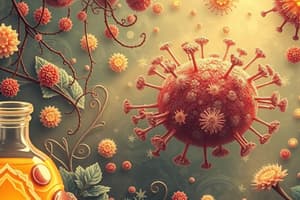Podcast
Questions and Answers
What are the primary differences between disinfectants and antiseptics?
What are the primary differences between disinfectants and antiseptics?
Disinfectants kill vegetative cells on surfaces, while antiseptics kill vegetative cells on living tissue.
Why are narrow spectrum drugs preferred over broad spectrum drugs?
Why are narrow spectrum drugs preferred over broad spectrum drugs?
Narrow spectrum drugs are preferred because they target specific pathogens and cause less damage to the normal microbiota.
What is intrinsic resistance in relation to antibiotics?
What is intrinsic resistance in relation to antibiotics?
Intrinsic resistance refers to the natural immunity that certain organisms have against specific antibiotics.
Describe the significance of the Kirby-Bauer method.
Describe the significance of the Kirby-Bauer method.
In the context of the Filter Paper Disk Method, what do zones of inhibition indicate?
In the context of the Filter Paper Disk Method, what do zones of inhibition indicate?
How does misuse and overuse of antibiotics contribute to acquired resistance?
How does misuse and overuse of antibiotics contribute to acquired resistance?
Identify two factors to consider when selecting a disinfectant for real-world application.
Identify two factors to consider when selecting a disinfectant for real-world application.
What role do second metabolites play in the life cycle of Streptomyces?
What role do second metabolites play in the life cycle of Streptomyces?
Why might healthcare providers opt for broad spectrum antibiotics without knowing the pathogen's identity?
Why might healthcare providers opt for broad spectrum antibiotics without knowing the pathogen's identity?
Explain why antiseptics might not always be effective outside of laboratory settings.
Explain why antiseptics might not always be effective outside of laboratory settings.
Flashcards
Disinfectant
Disinfectant
An agent used to kill vegetative cells on surfaces.
Antiseptic
Antiseptic
An agent used to kill vegetative cells on living tissue.
Synthetic antibiotic
Synthetic antibiotic
Lab-made antibiotic.
Semi-synthetic antibiotic
Semi-synthetic antibiotic
Signup and view all the flashcards
Narrow-spectrum drug
Narrow-spectrum drug
Signup and view all the flashcards
Broad-spectrum drug
Broad-spectrum drug
Signup and view all the flashcards
Acquired resistance
Acquired resistance
Signup and view all the flashcards
Intrinsic resistance
Intrinsic resistance
Signup and view all the flashcards
Filter Paper Disk Method
Filter Paper Disk Method
Signup and view all the flashcards
Kirby-Bauer Method
Kirby-Bauer Method
Signup and view all the flashcards
Study Notes
Disinfectants and Antiseptics
- Disinfectants kill vegetative cells on surfaces
- Antiseptics kill vegetative cells on living tissue
- Synthetic antibiotics are lab-made
- Semi-synthetic antibiotics are modified naturally-produced antibiotics
- Narrow-spectrum drugs are preferred; target pathogens without harming normal microbiota
- Broad-spectrum drugs are used when the infection cause is unknown or other antibiotics are ineffective
- Intrinsic resistance is natural immunity
- Acquired resistance is immunity from antibiotic misuse or overuse
- Susceptibility refers to being influenced by something
Streptomyces Bacteria
- Gram-positive
- Saprophytic (feed off decaying matter)
- Spore-forming
- Found in soil
- Produce secondary metabolites (organic compounds aiding interacting organisms)
Antibiotic Testing Methods
-
Filter Paper Disk Method/Agar Disk Diffusion Assay:
- Observe zones of inhibition (areas with no bacterial growth around disks) to assess disinfectant effectiveness
- Zephiron Chloride and Vesphene disinfectants showed good results against E. coli and S. aureus.
-
Kirby-Bauer Method:
- Uses Mueller-Hinton Agar on larger plates for testing multiple antibiotics
- Identify zones of inhibition for antibiotic susceptibility
Antibiotic Susceptibility Findings
- Small colonies within inhibition zones indicate natural resistance to some antibiotics.
- Antibiotic effectiveness varies among bacteria.
- Understanding antibiotic susceptibility chart values is crucial.
Antibiotic Review
- Disinfectant or antiseptic effectiveness in a lab setting doesn't guarantee real-world effectiveness due to environmental factors.
- Consider these factors when choosing a disinfectant: cost, water solubility, short exposure time, long shelf life, and non-toxicity.
- Health care providers may choose broad-spectrum antibiotics when infection cause is unclear.
- Misuse (using antibiotics for viral infections) and overuse (incorrect dosage) contribute to acquired bacterial resistance.
Studying That Suits You
Use AI to generate personalized quizzes and flashcards to suit your learning preferences.




